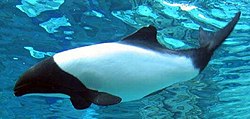Extant species
It consists of six species:
| Image | Common name | Scientific name | Distribution |
|---|
 | Peale's dolphin | C. australis | Southern South America |
 | Commerson's dolphin | C. commersonii | Argentina including Puerto Deseado, in the Strait of Magellan and around Tierra del Fuego, and near the Falkland Islands, near the Kerguelen Islands in the southern part of the Indian Ocean |
 | Hourglass dolphin | C. cruciger | Argentina, Chile, New Zealand |
 | Chilean dolphin | C. eutropia | coast of Chile |
 | Heaviside's dolphin | C. heavisidii | coast of northern Namibia at 17°S and as far south as the southern tip of South Africa |
 | Hector's dolphin | C. hectori | coastal regions of New Zealand |
|
The species have similar physical features—they are small, generally playful, blunt-nosed dolphins—but they are found in distinct geographical locations.
A phylogenetic analysis in 2006 indicated the two species traditionally assigned to the genus Lagenorhynchus , the hourglass dolphin L. cruciger and Peale's dolphin L. australis are actually phylogenetically nested among the species of Cephalorhynchus, and they suggested that these two species should be transferred to the genus Cephalorhynchus. Some acoustic and morphological data support this arrangement, at least with respect to Peale's dolphin. [2] In 2025 those two species were transferred to Cephalorhynchus. [3] [4]
According to a study in 1971, the Cephalorhynchus species are the only dolphins that do not whistle (no acoustic data are available for the hourglass dolphin). Peale's dolphin also shared with several Cephalorhynchus species the possession of a distinct white "armpit" marking behind the pectoral fin. [5]
This page is based on this
Wikipedia article Text is available under the
CC BY-SA 4.0 license; additional terms may apply.
Images, videos and audio are available under their respective licenses.






